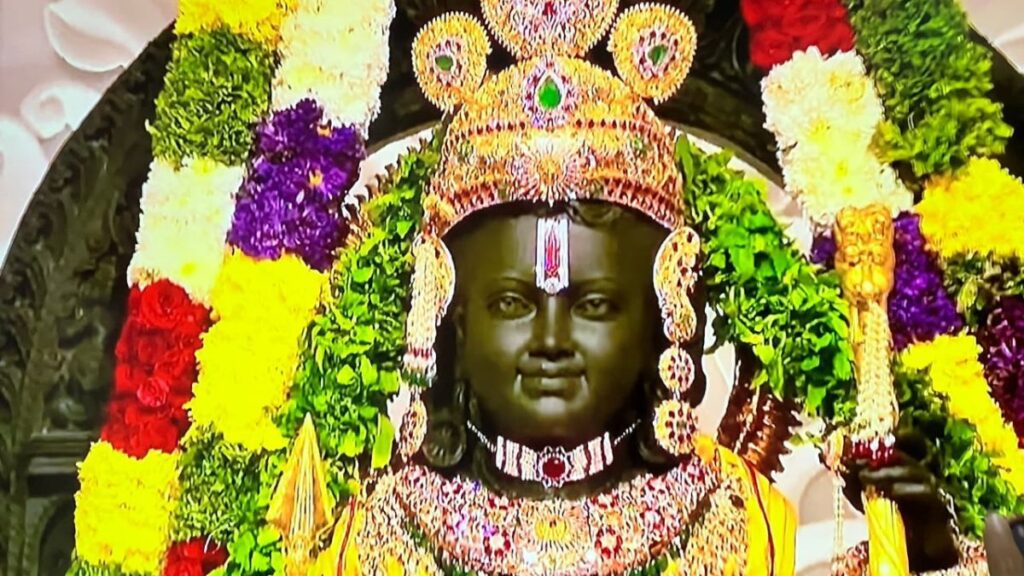“In the expansive realm of Hindu mythology and spirituality, Lord Rama’s iconography emerges as a powerful representation of virtue, righteousness, and divine leadership. Going beyond mere aesthetic beauty, Lord Rama’s iconography is a profound tapestry of symbolism, with each carefully chosen element conveying deeper spiritual meanings.”
Unlocking Lord Rama’s Iconography: The Cosmic Blue Hue and Transcendental Symbolism
At the heart of Lord Rama’s iconography is his physical appearance, often portrayed with a blue complexion. This symbolism harks back to his divine origin as an incarnation of Lord Vishnu, whose avatars are often associated with a blue hue. The color blue represents the infinite and the cosmic, underlining Lord Rama’s transcendental nature and his connection to the cosmic order.
Lord Rama is commonly depicted holding a bow and arrow, the symbols of his prowess as a warrior. The bow, named “Kodanda,” symbolizes his ability to uphold dharma (righteousness) and maintain cosmic order. The arrow represents the power to destroy evil forces and restore balance. Together, they signify Lord Rama’s unwavering commitment to protecting righteousness and defeating adharma (unrighteousness).
Another prominent feature is Lord Rama’s attire, often adorned in royal garments and regal jewelry. This attire symbolizes his role as a king and the embodiment of ideal leadership. It reflects the values of duty, responsibility, and nobility, inspiring devotees to embrace these qualities in their own lives.
Divine Relationship in the Image of Lord Rama: The Union of Sita and the Devotion of Hanuman
Lord Rama’s beloved consort, Sita, is an integral part of his iconography. The depiction of Lord Rama and Sita together embodies the divine union of masculine and feminine energies, symbolizing the harmonious balance in creation. Their bond becomes a model for conjugal love, devotion, and partnership, reflecting the divine interplay of Shakti and Shiva.
The presence of Lord Rama’s loyal devotee, Hanuman, is another layer of symbolism. Hanuman is often portrayed kneeling at Lord Rama’s feet, signifying unwavering devotion and surrender. His role as a devoted servant exemplifies the importance of surrendering to the divine will and serving a higher purpose.
Symbolism of the Lotus in the Depiction of Lord Rama: Purity and Spiritual Resilience
The lotus, a recurring motif in Lord Rama’s iconography, represents purity and spiritual enlightenment. The lotus emerges untainted from the murky waters, symbolizing the soul’s journey toward spiritual awakening amidst the challenges of life. Lord Rama’s association with the lotus emphasizes his ability to rise above adversity with grace and purity.
In many depictions, Lord Rama is shown with a quiver, signifying his readiness to face challenges and protect dharma. The quiver is a repository of arrows, each representing a specific virtue or divine quality. This symbolism encourages devotees to cultivate virtues and face life’s challenges with courage and righteousness.
Sacred Footprints: Padukas of Lord Rama and symbol of the path of humility
The presence of Lord Rama’s sandals in his iconography holds a unique symbolism. Devotees believe that seeking the dust from Lord Rama’s sandals represents humility and a surrender to the divine. It is a reminder to tread the path of righteousness with humility and devotion.
Conclusion:
In essence, unraveling the symbolism behind Lord Rama’s iconography is a journey into the profound layers of Hindu spirituality. Each element, from the color of his skin to the accessories he carries, is a carefully chosen symbol that imparts spiritual teachings and inspires devotees to lead a life aligned with dharma, devotion, and righteousness. Lord Rama’s iconography serves as a timeless source of inspiration, inviting believers to reflect on the deeper meanings and integrate these divine qualities into their own lives.

